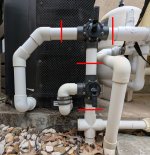- May 30, 2012
- 1,782
- Pool Size
- 17000
- Surface
- Plaster
- Chlorine
- Salt Water Generator
- SWG Type
- CircuPool Edge-40
I will be replumbing for a new cartridge filter and moving my SWG soon and have a few questions.
1. Best way to saw a square end on existing pipes? (Hacksaw?)
2. How to remove white paint? Is 180g sandpaper fine enough?
3. Can fitting be dry fit and come apart? (I have a couple 45's that could be tricky)
4. How long to set before use?
1. Best way to saw a square end on existing pipes? (Hacksaw?)
2. How to remove white paint? Is 180g sandpaper fine enough?
3. Can fitting be dry fit and come apart? (I have a couple 45's that could be tricky)
4. How long to set before use?



